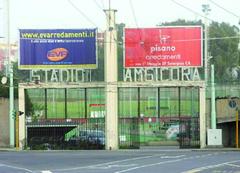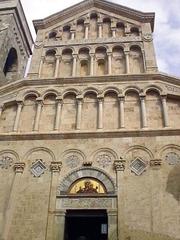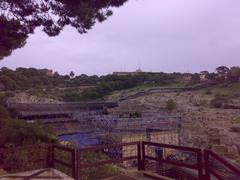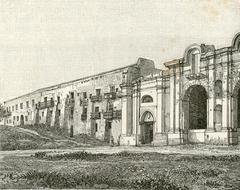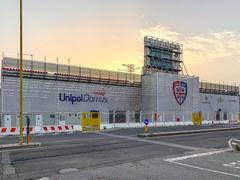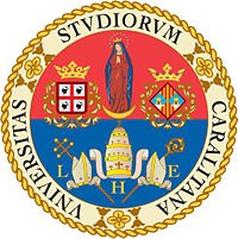National Pinacotheca of Cagliari: Visiting Hours, Tickets, and Your Guide to Cagliari’s Historical Sites
Date: 04/07/2025
Introduction
The National Pinacotheca of Cagliari (Pinacoteca Nazionale di Cagliari) is a cultural gem nestled in the Castello district, offering a sweeping journey through Sardinia’s artistic and historical narrative. Housed within the Citadel of Museums and overlooking the city’s ancient Spanish walls, the Pinacotheca is renowned for its unrivaled collection of sacred retables, Baroque masterpieces, and ethnographic treasures. This guide provides detailed information on visiting hours, ticket options, accessibility, and tips for exploring the broader cultural landscape of Cagliari, ensuring a rewarding experience for every visitor (Wikipedia; CagliariMag).
Table of Contents
- Introduction
- Historical Development and Cultural Significance
- The Collection: Key Highlights
- Practical Visitor Information
- The Pinacotheca’s Role in Sardinian Heritage
- Exploring Cagliari: Nearby Historical Sites
- Visitor Tips and FAQs
- Conclusion and Recommendations
- References
Historical Development and Cultural Significance
Founded in the aftermath of the 19th-century suppression of religious orders, the National Pinacotheca’s original nucleus consisted of paintings and ecclesiastical art transferred to public ownership (Wikipedia). The removal of these works from churches, especially after the 1866 Royal Decree, played a pivotal role in establishing one of Sardinia’s richest museum collections (CagliariMag).
Significant expansion occurred with acquisitions from the destroyed Church of San Francesco di Stampace, including retables by the famed Cavaro brothers. Over time, the museum broadened its scope, integrating ethnographic collections and donations from private collectors, and relocating to its current neoclassical setting within the Citadel of Museums in 1992 (WhichMuseum).
The Collection: Key Highlights
Iberian and Sardinian Retables
A hallmark of the Pinacotheca is its array of late-medieval and Renaissance retables, or multi-paneled altarpieces, many with roots in the now-lost Church of San Francesco di Stampace. The Cavaro brothers’ works exemplify the Stampacina School’s synthesis of Flemish, Catalan, and Renaissance influences, while the monumental Retablo of Villamar, attributed to the Master of Castelsardo, stands out as a masterwork of Sardinian religious art (CagliariMag; WhichMuseum).
Baroque and Renaissance Paintings
The museum’s galleries include paintings from the 15th to 18th centuries, featuring Genoese, Neapolitan, and Roman schools. Notable works by Domenico Fiasella and Alvaro Pirez d’Evora reflect the stylistic currents that shaped Sardinian religious and civic art in the Baroque era (Wikipedia).
19th–20th Century Sardinian Art & Ethnographic Holdings
On the lower floors, visitors encounter portraits, rural scenes, and landscapes by artists such as Mario Delitala, Antonio Ballero, and Filippo Figari, capturing the essence of Sardinian life in the modern era (Estate in Sardegna). The ethnographic collection, displayed on a rotating basis, features jewelry, textiles, ceramics, and a rare 12th-century bronze aquamanile, illuminating Sardinian craftsmanship and daily life (CagliariMag).
Practical Visitor Information
Visiting Hours and Tickets
- Opening Hours: Tuesday to Sunday, 09:00–20:00. Last admission is typically one hour before closing. Closed on Mondays. Hours may vary on holidays—check the official website for updates (WhichMuseum).
- Tickets: Standard admission ranges from €5–€8. Discounts for EU citizens aged 18–25, seniors, and residents; children under 18 enter free. Combined tickets with other museums in the Citadel may be available.
- Purchase: Buy tickets in person or online via the Cagliari Turismo website to avoid queues.
Accessibility and Facilities
- Mobility: Elevators and ramps provide access to all floors, though some historic areas may be less accessible. Accessible restrooms and staff assistance are available.
- Facilities: Restrooms, cloakroom, free Wi-Fi, and a gift shop are provided. The IDEHA platform offers audio guides and digital content (IDEHA).
Guided Tours and Photography
- Tours: Guided tours and audio guides are available in Italian and English; advance booking is recommended for groups.
- Photography: Non-flash photography is allowed in most galleries. Confirm current policies at the entrance.
The Pinacotheca’s Role in Sardinian Heritage
Serving as a repository of regional identity, the Pinacotheca preserves and interprets Sardinia’s artistic legacy from the Middle Ages through the 20th century. Its educational mission is reflected in curated exhibitions, informative displays, and cultural programming. Together with neighboring institutions in the Citadel of Museums, it forms a vibrant cultural hub in Cagliari’s Castello district (WhichMuseum; Estate in Sardegna).
Exploring Cagliari: Nearby Historical Sites
Citadel and Castello District
- National Archaeological Museum: Renowned for ancient Sardinian artifacts.
- Museum of Siamese Art and Museo delle Cere Anatomiche: Offering international and scientific collections.
- Cagliari Cathedral: A blend of Romanesque and Baroque architecture.
- Bastione San Remy: Panoramic terrace over the city (PlanetWare).
- Torre dell’Elefante and Torre di San Pancrazio: Medieval defensive towers.
Beyond the Citadel
- Roman Amphitheatre: Ancient site near the Citadel (The Crazy Tourist).
- Poetto Beach: Easily accessible for a seaside escape (Savoring Italy).
- Orto Botanico di Cagliari: The city’s botanical garden.
Visitor Tips and Frequently Asked Questions
Q: What are the museum’s visiting hours?
A: Tuesday to Sunday, 09:00–20:00; closed Mondays. Check for holiday updates.
Q: How do I buy tickets?
A: Purchase at the entrance or online.
Q: Is the museum accessible?
A: Yes; elevators and ramps connect all floors. Some historic areas may be limited.
Q: Are guided tours available?
A: Yes; book in advance, especially for groups.
Q: Can I take photos in the galleries?
A: Non-flash photography is generally permitted; check for signage.
Q: What else should I see nearby?
A: Don’t miss the National Archaeological Museum, Bastione San Remy, and Cagliari Cathedral.
Q: When is the best time to visit?
A: Spring and autumn offer pleasant weather and smaller crowds (Savoring Italy).
Conclusion and Recommendations
The National Pinacotheca of Cagliari stands as a vital gateway to Sardinia’s artistic and cultural heritage. Its impressive collections, accessible facilities, and panoramic setting within the Castello district make it an essential stop for art lovers, history enthusiasts, and travelers alike. By planning your visit around the museum’s opening hours, purchasing tickets in advance, and exploring the surrounding historical sites, you’ll gain a deeper appreciation for Cagliari’s unique identity within the Mediterranean context.
For an enhanced experience, consider guided tours and digital resources available through the IDEHA platform or the Audiala app. Take time to enjoy local cuisine, stroll the historic streets, and absorb the panoramic views from the Citadel. The Pinacotheca and its surroundings offer a rich, immersive journey through Sardinia’s past and present.
References
- Wikipedia – Pinacoteca Nazionale di Cagliari
- CagliariMag – Cagliari Art Gallery
- WhichMuseum – National Pinacotheca of Cagliari
- PlanetWare – Cagliari Attractions
- Savoring Italy – Cagliari Guide
- IDEHA – Pinacoteca Nazionale di Cagliari
- The Crazy Tourist – Best Things to Do in Cagliari
- Holidaymaker.ai – Cagliari
- FeelTheArt – Pinacoteca Nazionale di Cagliari
- Go Ask a Local – Cagliari Travel Guide
